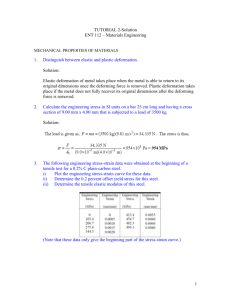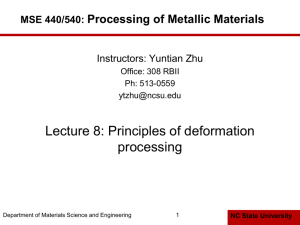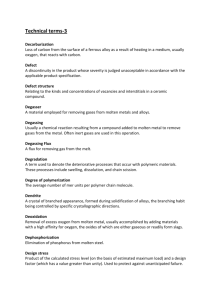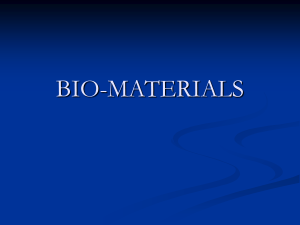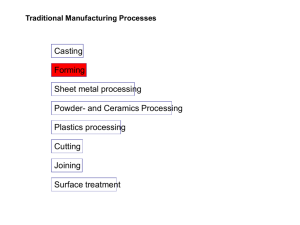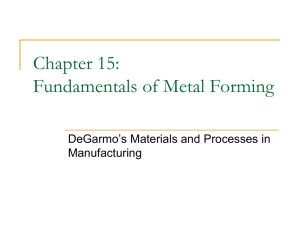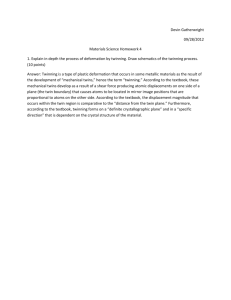hot working - Hacettepe University Department of Mechanical
advertisement
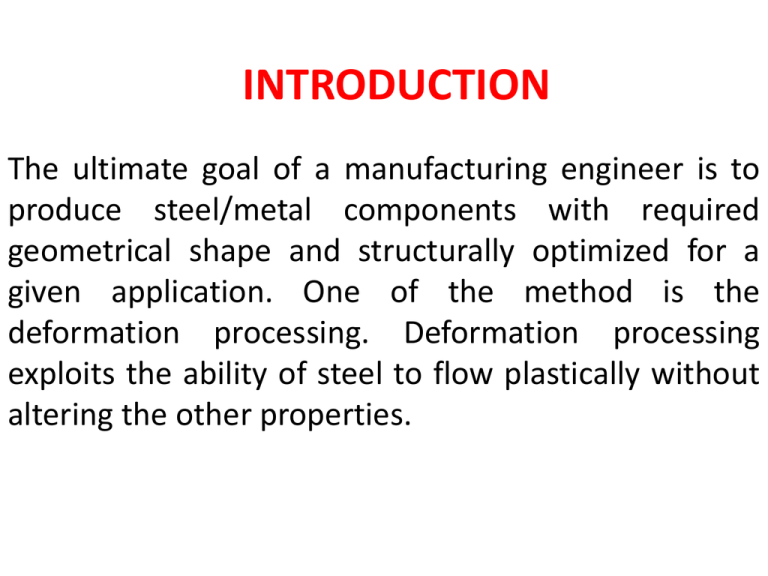
INTRODUCTION The ultimate goal of a manufacturing engineer is to produce steel/metal components with required geometrical shape and structurally optimized for a given application. One of the method is the deformation processing. Deformation processing exploits the ability of steel to flow plastically without altering the other properties. INTRODUCTION The required forces are often very high. Cast ingots, slabs, blooms and billets are reduced in size and converted into plates, sheets, rods and others. These forms experience further deformation to produce the desired products formed by processes such as forging, extrusion and other sheet metal forming. The deformation may be bulk flow in three dimensions, simple shearing, simple bending, or any combination of these and other processes. The stresses could either be tensile or compressive or shear or combination of them. In this connection the steel chemistry and cleanliness are important factors for deformation processing. INTRODUCTION Some aspect of deformation processing will be discussed. This is given to appreciate the efforts of steelmakers or any other metalmakers in producing quality steels and/or metals. Deformation processing can be carried out either under hot or cold condition. HOT AND COLD PROCESSES (WORKING) Hot Working The distinction between hot working and cold working does not depends solely on the temperature, but rather on the processing temperature with respect to the material recrystallization temperature. When the processing temperature of the mechanical deformation of steel is above the recrystallization temperature, the process is termed as hot working; otherwise, it is cold working. For hot working processes, large deformation can be successively repeated, as the metal remains soft and ductile. The hardness of the material cannot be controlled after hot rolling and it is a function of chemical composition and the rate of cooling after rolling. The hardness is generally lower than that of cold rolling and the required deformation energy is lesser as well. However most metal will experience some surface oxidation resulting in material loss and poor final surface finish. HOT WORKING • Hot working does not produce strain hardening. Hence no increase in either yield strength or hardness occurs. In addition yield strength decreases as temperature increases and the ductility improves. • Hot working can be used to drastically alter the shape of metals without fear of fracture and excessively high forces. HOT WORKING • Elevated temperatures promote diffusion that can remove chemical inhomogeneties; pores can be welded or reduced in size during deformation. • The dendritic grain structure, small gas cavities and shrinkage porosity formed during solidification in large sections can be modified by hot working to produce a fine, randomly oriented, sphericalshaped grain structure which results in a net increase in ductility and toughness. HOT WORKING • Hot working results in reorientation of inclusions or impurity particles in the metal with the result that an impurity originally oriented so as to aid crack movement through the metal can be reoriented into a “crack arrestor” configuration. HOT AND COLD PROCESSES (WORKING) Cold Working Cold working processes allow desirable metal qualities that cannot be obtained by hot working, such as eliminating errors attending shrinkage. As such, a much more compact and higher dimensional accuracy metal can be obtained with cold working. Furthermore, the final products have a smoother surface (better surface finish) than those of hot working and the strength, hardness as well as the elastic limit are increased. However, the ductility of the metal decreases due to strain hardening thus making the metal more brittle. As such, the metal must be heated from time to time (annealed) during the rolling operation to remove the undesirable effects of cold working and to increase the workability of the metal. COLD WORKING • Some advantages of cold working are: No heating is required Better surface finish and superior dimensional control are achieved Strength, fatigue, and wear properties are improved Directional properties can be imparted COLD WORKING • Disadvantages of cold working are: Heavier forces are required Strain hardening occurs (may require intermediate annealing treatment to relieve internal stresses) Residual stresses may be produced For cold working, the ductility and the yield point stress of steel are important. FOUR BASIC BULK DEFORMATION PROCESSES • ROLLING-Slab or plate is squeezed between opposing rolls • FORGING-Work is squeezed and shaped between opposing dies • EXTRUSION- Work is squeezed through a die opening, thereby taking the shape of the opening • WIRE AND BAR DRAWING- Diameter of wire or bar is reduced by pulling it through a die opening SCHEMATICS ROLLING SCHEMATICS FORGING SCHEMATIC EXTRUSION SCHEMATIC FORGING MOVIE ROLLING MOVIE
